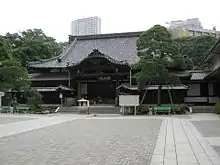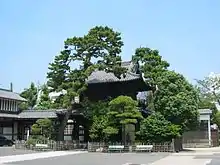Sengaku-ji
Sengaku-ji (泉岳寺) is a Sōtō Zen Buddhist temple located in the Takanawa neighborhood of Minato-ku, near Sengakuji Station and Shinagawa Station, Tokyo, Japan.
| Sengaku-ji 泉岳寺 | |
|---|---|
 Main Hall | |
| Religion | |
| Affiliation | Sōtō |
| Deity | Shaka Nyorai (Śākyamuni) |
| Location | |
| Location | 11-1, Takanawa 2-chōme, Minato-ku, Tokyo Prefecture |
| Country | Japan |
 Shown within Japan | |
| Geographic coordinates | 35°38′16″N 139°44′11″E |
| Architecture | |
| Founder | Monnan Sōkan and Tokugawa Ieyasu |
| Completed | 1612 |


History
The temple became famous through the Akō incident of the forty-seven Rōnin in the 18th century. The tomb of Lord Asano Takumi-no-Kami Naganori is located here, who was forced to commit ritual suicide after he broke protocol and drew a sword in the Edo Castle.
His retainers the forty-seven Rōnin led by Oishi Kuranosuke avenged his death, washed his opponent's head in a water well and presented it on the altar in front of his tomb. Afterwards they were ordered by the Shōgun to commit ritual suicide and were also buried here next to their master. Their story became famous through the Kabuki epic Chūshingura and their graves became a popular site of pilgrimage.
Each year on December 14, the temple holds a festival commemorating the 47 Rōnin.
External links
![]() Media related to Sengakuji at Wikimedia Commons
Media related to Sengakuji at Wikimedia Commons
- (in Japanese) Sengaku-ji - homepage
- National Diet Library: photograph of Sengaku-ji (1900)